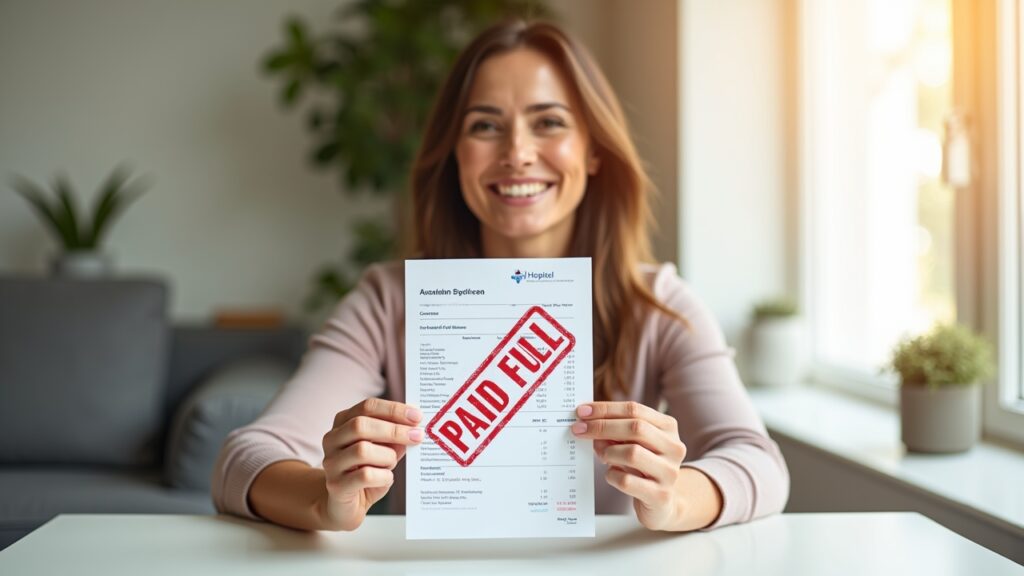Advertisements
Did you know that nearly 100 million Americans are drowning in medical debt? Yeah, that stat knocked me sideways too! When I first learned about medical debt forgiveness programs, I couldn’t believe they actually existed.
Let me tell you, discovering these options literally saved my sanity after my unexpected surgery left me with a $47,000 bill. Honestly, I thought I was doomed.
But here’s the thing – medical debt forgiveness is real, and more importantly, it’s probably more accessible than you think! Throughout this post, I’ll share everything I’ve learned about navigating this confusing world, including some mistakes I made along the way.
What Exactly Is Medical Debt Forgiveness?

So basically, medical debt forgiveness happens when a hospital or healthcare provider agrees to reduce or completely wipe out what you owe. Sounds too good to be true, right? That’s exactly what I thought when my neighbor first mentioned it.
However, these programs exist because hospitals actually budget for them! Most non-profit hospitals are legally required to offer charity care programs, which is fancy talk for helping folks who can’t afford their bills.
Furthermore, there’s different types of forgiveness available. Sometimes it’s a complete write-off, other times it’s a huge reduction, and occasionally they’ll set up super affordable payment plans that eventually get forgiven.
Who Actually Qualifies for These Programs?
OK, so here’s where I initially messed up big time. I assumed I made too much money to qualify for any help. Boy, was I wrong!
Generally speaking, if your income is below 200-400% of the federal poverty level, you’ve got a decent shot. For reference, that’s roughly $60,000-$120,000 for a family of four, depending on the hospital’s specific guidelines.
Moreover, some hospitals look at your medical bills compared to your income. If your bills exceed 10% of your annual income, you might qualify even if you’re above those income limits. Additionally, having insurance doesn’t disqualify you – something else I didn’t know at first!
The Step-by-Step Process I Followed
Alright, let me walk you through exactly what I did. First, I called the hospital’s billing department and asked about financial assistance programs. The lady on the phone was actually super helpful, which surprised me.
Next, I gathered all my documents – tax returns, pay stubs, bank statements, the works. Pro tip: make copies of everything because some hospitals lose paperwork (learned that the hard way).
Then, I filled out their financial assistance application. It was lengthy, not gonna lie. But spending those two hours potentially saved me thousands, so totally worth it!
The Waiting Game
After submitting everything, the waiting was brutal. It took about 30 days to hear back, during which I definitely lost some sleep. When they finally called, they’d approved a 75% reduction!
Subsequently, I had to sign some paperwork and set up a payment plan for the remaining balance. The whole process took about 6 weeks from start to finish.
Common Mistakes to Avoid
Listen, I made plenty of mistakes during this journey. First off, I waited way too long to apply – almost missed the deadline because I was too embarrassed to ask for help.
Another biggie? Not being completely honest on the application. My friend tried to hide some assets and got denied because of it. Just be straight up about your situation.
Also, don’t ignore those bills while waiting for approval! I learned that continuing to communicate with the billing department shows good faith. Plus, it prevents your account from going to collections, which is a whole other nightmare.
Alternative Options Worth Exploring
Sometimes traditional forgiveness programs aren’t available or you don’t qualify. Nevertheless, there’s still hope! Many hospitals offer prompt-pay discounts if you can pay a lump sum.
Additionally, negotiating directly with the billing department works more often than you’d think. I’ve helped friends reduce bills by 30-50% just by asking and explaining their situation.
Furthermore, organizations like RIP Medical Debt buy and forgive medical debt for pennies on the dollar. While you can’t apply directly, it’s worth checking if your debt might be eligible.
What Your Next Steps Are

Look, dealing with medical debt absolutely sucks – there’s no sugarcoating it. However, knowing these forgiveness options exist can be the difference between bankruptcy and bouncing back.
Remember, there’s no shame in asking for help when medical bills threaten your financial stability. Actually, I’d argue it’s the smart, responsible thing to do!
Start by calling your hospital’s financial assistance office today. Seriously, don’t wait like I did. The sooner you apply, the sooner you can stop losing sleep over those bills.
Finally, if you found this helpful, check out more money-saving tips and financial guidance at The Clear Cents. We’re all about helping regular folks navigate tricky financial situations without the confusing jargon!




[…] more tips on managing your money and making smart financial choices? Check out other helpful guides at Clear Cents – we’re all about making finances less scary and more […]